Effect of Crosslinkers on Optical and Mechanical Behavior of Chiral Nematic Liquid Crystal Elastomers
Abstract
1. Introduction
2. Results and Discussion
2.1. Phase Transition Behavior
2.2. Optical Properties of N*LCEs
2.3. Mechano-Optical Properties
3. Materials and Methods
3.1. Materials
3.2. Synthesis of CHA
3.3. Preparation of Polydimethylsiloxane Films
3.4. Preparation of N*LCEs
3.5. Characterization
4. Conclusions
Author Contributions
Funding
Institutional Review Board Statement
Informed Consent Statement
Data Availability Statement
Acknowledgments
Conflicts of Interest
Sample Availability
References
- Ryabchun, A.; Bobrovsky, A. Cholesteric liquid crystal materials for tunable diffractive optics. Adv. Opt. Mater. 2018, 6, 1800335. [Google Scholar] [CrossRef]
- White, T.J.; McConney, M.E.; Bunning, T.J. Dynamic color in stimuli-responsive cholesteric liquid crystals. J. Mater. Chem. 2010, 20, 9832–9847. [Google Scholar] [CrossRef]
- Guo, J.; Wu, H.; Chen, F.; Zhang, L.; He, W.; Yang, H.; Wei, J. Fabrication of multi-pitched photonic structure in cholesteric liquid crystals based on a polymer template with helical structure. J. Mater. Chem. 2010, 20, 4094–4102. [Google Scholar] [CrossRef]
- Tokunaga, S.; Itoh, Y.; Tanaka, H.; Araoka, F.; Aida, T. Redox-responsive chiral dopant for quick electrochemical color modulation of cholesteric liquid crystal. J. Am. Chem. Soc. 2018, 140, 10946–10949. [Google Scholar] [CrossRef] [PubMed]
- Lin, J.D.; Lin, H.Y.; Wei, G.J.; Chuang, Y.C.; Chen, L.J.; Mo, T.S.; Lee, C.R. A broadban-tunable photonic bandgap and thermally convertible laser with an ultra-low lasing threshold from a refilled chiral polymer template. J. Mater. Chem. C 2019, 7, 4740–4747. [Google Scholar] [CrossRef]
- Mulder, D.J.; Schenning, A.P.H.J.; Bastiaansen, C.W.M. Chiral-nematic liquid crystals as one dimensional photonic materials in optical sensors. J. Mater. Chem. C 2014, 2, 6695–6705. [Google Scholar] [CrossRef]
- Fu, P.; Ye, P.; Yu, Z.; Lu, H. Bragg reflection from a cholesteric liquid-crystal slab in the framework of nonlinear optics. J. Opt. Soc. Am. B 1987, 4, 1392–1396. [Google Scholar] [CrossRef]
- Bian, Z.; Li, K.; Huang, W.; Cao, H.; Yang, H. Characteristics of selective reflection of chiral nematic liquid crystalline gels with a nonuniform pitch distribution. Appl. Phys. Lett. 2007, 91, 201908. [Google Scholar] [CrossRef]
- Hu, W.; Zhang, L.; Cao, H.; Song, L.; Zhao, H.; Yang, Z.; Cheng, Z.; Yang, H.; Guo, L. Electro-optical study of chiral nematic liquid crystal/chiral ionic liquid composites with electrically controllable selective reflection characteristics. Phys. Chem. Chem. Phys. 2010, 12, 2632–2638. [Google Scholar] [CrossRef]
- Humar, M.; Muševič, I. 3D microlasers from self-assembled cholesteric liquid-crystal microdroplets. Opt. Express 2010, 18, 26995–27003. [Google Scholar] [CrossRef]
- Schwartz, M.; Lenzini, G.; Geng, Y.; Rønne, P.B.; Ryan, P.Y.A.; Lagerwall, J.P.F. Cholesteric liquid crystal shells as enabling material for information-rich design and architecture. Adv. Mater. 2018, 30, 1707382. [Google Scholar] [CrossRef] [PubMed]
- John, W.D.S.; Fritz, W.J.; Lu, Z.J.; Yang, D.K. Bragg reflection from cholesteric liquid crystals. Phys. Rev. E 1995, 51, 1191. [Google Scholar] [CrossRef] [PubMed]
- Kahn, F.J. Cholesteric liquid crystals for optical applications. Appl. Phys. Lett. 1971, 18, 231. [Google Scholar] [CrossRef]
- Picot, O.T.; Dai, M.; Billoti, E.; Broer, D.J.; Peijs, T.; Bastiaansen, C.W.M. A real time optical strain sensor based on a cholesteric liquid crystal network. RSC Adv. 2013, 3, 18794–18798. [Google Scholar] [CrossRef]
- Foelen, Y.; Van Der Heijden, D.A.C.; del Pozo, M.; Lub, J.; Bastiaansen, C.W.M.; Schenning, A.P.H.J. An optical steam sterilization sensor based on a dual-responsive supramolecular cross-linked photonic polymer. ACS Appl. Mater. Interfaces 2020, 12, 16896–16902. [Google Scholar] [CrossRef]
- Zhang, B.Y.; Hu, J.S.; Wang, Y.; Qian, J.H. Synthesis and properties of side-chain cholesteric liquid crystalline elastomers containing tetra-vinyl crosslinking units. Polym. J. 2003, 35, 476–483. [Google Scholar] [CrossRef][Green Version]
- Khandelwal, H.; Timmermans, G.H.; Debije, M.G.; Schenning, A.P.H.J. Dual electrically and thermally responsive broadband reflectors based on polymer network stabilized chiral nematic liquid crystals: The role of crosslink density. Chem. Commun. 2016, 52, 10109–10112. [Google Scholar] [CrossRef]
- Varanytsia, A.; Nagai, H.; Urayama, K.; Palffy-Muhoray, P. Tunable lasing in cholesteric liquid crystal elastomers with accurate measurements of strain. Sci. Rep. 2015, 5, 17739. [Google Scholar] [CrossRef]
- Yusuf, Y.; Ono, Y.; Sumisaki, Y.; Cladis, P.E.; Brand, H.R.; Finkelmann, H.; Kai, S. Swelling dynamics of liquid crystal elastomers swollen with low molecular weight liquid crystals. Phys. Rev. E 2004, 69, 021710. [Google Scholar] [CrossRef]
- Meng, F.B.; Lian, J.; Chen, H.B.; Gao, Y.M.; Zhang, B.Y. Cholesteric liquid-crystalline thermosets derived from side-chain liquid-crystalline epoxy oligomers. High Perform. Polym. 2008, 21, 64–78. [Google Scholar]
- Hu, J.S.; Zhang, B.Y.; Yao, D.S.; Zhou, A.J. Cholesteric liquid crystalline thermosets: Synthesis, structure and properties of ChLCTs/precursor polymers. Liq. Cryst. 2004, 31, 393–400. [Google Scholar] [CrossRef]
- Mamiya, J. Photomechanical energy conversion based on cross-linked liquid-crystalline polymers. Polym. J. 2013, 45, 239–246. [Google Scholar] [CrossRef]
- Jiang, H.; Li, C.; Huanga, X. Actuators based on liquid crystalline elastomer materials. Nanoscale 2013, 5, 5225–5240. [Google Scholar] [CrossRef]
- Fuchigami, Y.; Takigawa, T.; Urayama, K. Electrical actuation of cholesteric liquid crystal gels. ACS Macro Lett. 2014, 3, 813–818. [Google Scholar] [CrossRef]
- Nagai, H.; Urayama, K. Thermal response of cholesteric liquid crystal elastomers. Phys. Rev. E 2015, 92, 022501. [Google Scholar] [CrossRef] [PubMed]
- Finkelmann, H.; Kim, S.T.; Muñoz, A.; Palffy-Muhoray, P.; Taheri, B. Tunable mirrorless lasing in cholesteric liquid crystalline elastomers. Adv. Mater. 2001, 13, 1069–1072. [Google Scholar] [CrossRef]
- Ku, K.; Hisano, K.; Kimura, S.; Shigeyama, T.; Akamatsu, N.; Shishido, A.; Tsutsumi, O. Environmentally stable chiral-nematic liquid-crystal elastomers with mechano-optical properties. Appl. Sci. 2021, 11, 5037. [Google Scholar] [CrossRef]
- Ku, K.; Kimura, S.; Yuasa, K.; Hisano, K.; Tsutsumi, O. Control of molecular-level mechano-optical response of chiral liquid-crystalline elastomers. Proc. SPIE 2020, 11477, 1147703. [Google Scholar]
- Liu, Z.P.; He, X.Z.; Cong, Y.H.; Zhang, B.Y.; Meng, F.B.; Tian, M.; Jia, Y.G. Synthesis and characterization of two series of pressure-sensitive cholesteric liquid crystal elastomers with optical properties. Liq. Cryst. 2020, 47, 143–153. [Google Scholar] [CrossRef]
- Jiang, Y.; Cong, Y.; Zhang, B. Synthesis and characterization of chiral smectic side-chain liquid crystalline elastomers containing nematic and chiral mesogens. New J. Chem. 2016, 40, 9352–9360. [Google Scholar] [CrossRef]
- Zhang, Y.S.; Jiang, S.A.; Lin, J.D.; Lee, C.R. Bio-inspired design of active photo-mechano-chemically dual-responsive photonic film based on cholesteric liquid crystal elastomers. J. Mater. Chem. C 2020, 8, 5517–5524. [Google Scholar] [CrossRef]
- Hu, J.S.; Zhang, B.Y.; Sun, K.; Li, Q.Y. Side chain cholesteric liquid crystalline elastomers: Synthesis and phase behaviour. Liq. Cryst. 2003, 30, 1267–1275. [Google Scholar] [CrossRef]
- Ma, Y.R.; Wang, D.X.; Cong, Y.H.; He, X.Z.; Zhang, B.Y.; Meng, F.B.; Jia, Y.G. Synthesis and properties of cholesteric liquid crystal elastomers with selective reflection centred on D(+)-camphoric acid. Liq. Cryst. 2020, 47, 1591–1603. [Google Scholar] [CrossRef]
- Zhang, B.Y.; Hu, J.S.; Jia, Y.G.; Du, B.G. Side-chain cholesteric liquid crystalline elastomers derived from nematic bis-olefinic crosslinking units. Macromol. Chem. Phys. 2003, 204, 2123–2129. [Google Scholar] [CrossRef]
- He, X.Z.; Zhang, B.Y.; Ma, W.W.; Zhang, L.; Mu, Q. Side-chain cholesteric liquid crystalline elastomers containing isosorbide as chiral agent—Synthesis and characterization. Liq. Cryst. 2009, 36, 847–854. [Google Scholar] [CrossRef]
- Thomas, R.; Yoshida, Y.; Akasaka, T.; Tamaoki, N. Influence of a change in helical twisting power of photoresponsive chiral dopants on rotational manipulation of micro-objects on the surface of chiral nematic liquid crystalline films. Chem. Eur. J. 2012, 18, 12337–12348. [Google Scholar] [CrossRef]
- Baessler, H.; Labes, M.M. Helical twisting power of steroidal solutes in cholesteric mesophases. J. Chem. Phys. 1970, 52, 631. [Google Scholar] [CrossRef]
- Sánchez-Ferrer, A.; Torras, N.; Esteve, J. Integration of liquid-crystalline elastomers in MEMS/MOEMS. In Liquid Crystalline Polymers, 1st ed.; Thakur, V.K., Kessler, M.R., Eds.; Springer: Cham, Switzerland, 2016; Volume 1, pp. 553–582. [Google Scholar]
- Jirón, V.; Castellón, E. Increased nematic–isotropic transition temperature on doping a liquid crystal with molecularly rigid carboxylic acids. J. Phys. Chem. B 2020, 124, 890–899. [Google Scholar] [CrossRef]
- Huang, C.; Qian, X.; Yang, R. Thermal conductivity of polymers and polymer nanocomposites. Mater. Sci. Eng. R Rep. 2018, 132, 1–22. [Google Scholar] [CrossRef]
- Wu, X.; Cao, H.; Guo, R.; Li, K.; Wang, F.; Yang, H. Effect of cholesteric liquid crystalline elastomer with binaphthalene crosslinkings on thermal and optical properties of a liquid crystal that show smectic A-cholesteric phase transition. Polym. Adv. Technol. 2013, 24, 228–235. [Google Scholar] [CrossRef]
- McConney, M.E.; White, T.J.; Tondiglia, V.P.; Natarajan, L.V.; Yang, D.; Bunning, T.J. Dynamic high contrast reflective coloration from responsive polymer/cholesteric liquid crystal architecture. Soft Matter 2012, 8, 318–323. [Google Scholar] [CrossRef]
- Pan, R.P.; Tsai, T.R.; Chen, C.Y.; Wang, C.H.; Pan, C.L. The refractive indices of nematic liquid crystal 4′-n-pentyl-4-cyanobiphenyl in the THz frequency range. Mol. Cryst. Liq. Cryst. 2004, 409, 137–144. [Google Scholar] [CrossRef]
- Li, Y.; Luo, D.; Peng, Z.H. Full-color reflective display based on narrow bandwidth templated cholesteric liquid crystal film. Opt. Mater. Express 2017, 7, 16–24. [Google Scholar] [CrossRef]
- Gharde, R.; Bhave, M.G. The study of refractive indices of liquid crystal mixtures. Mol. Cryst. Liq. Cryst. 2015, 613, 1–15. [Google Scholar] [CrossRef]
- Chen, Y.; Tan, L.; Chen, L.; Yang, Y.; Wang, X. Study on biodegradable aromatic/aliphatic copolyesters. Br. J. Chem. Eng. 2008, 25, 321–335. [Google Scholar] [CrossRef]
- Albuquerque, H.M.T.; Santos, C.M.M.; Silva, A.M.S. Cholesterol-based compounds: Recent advances in synthesis and applications. Molecules 2019, 24, 116. [Google Scholar] [CrossRef] [PubMed]
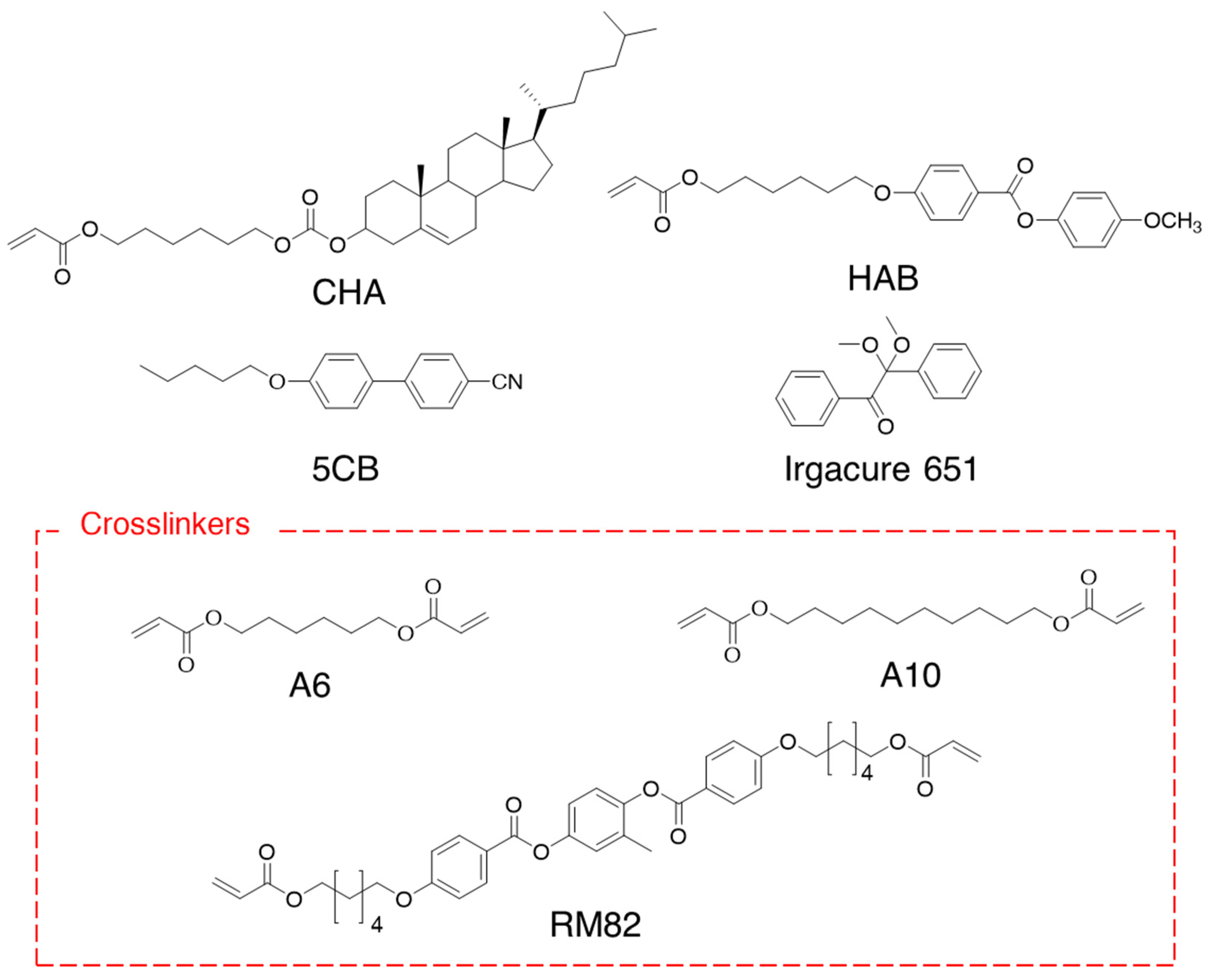
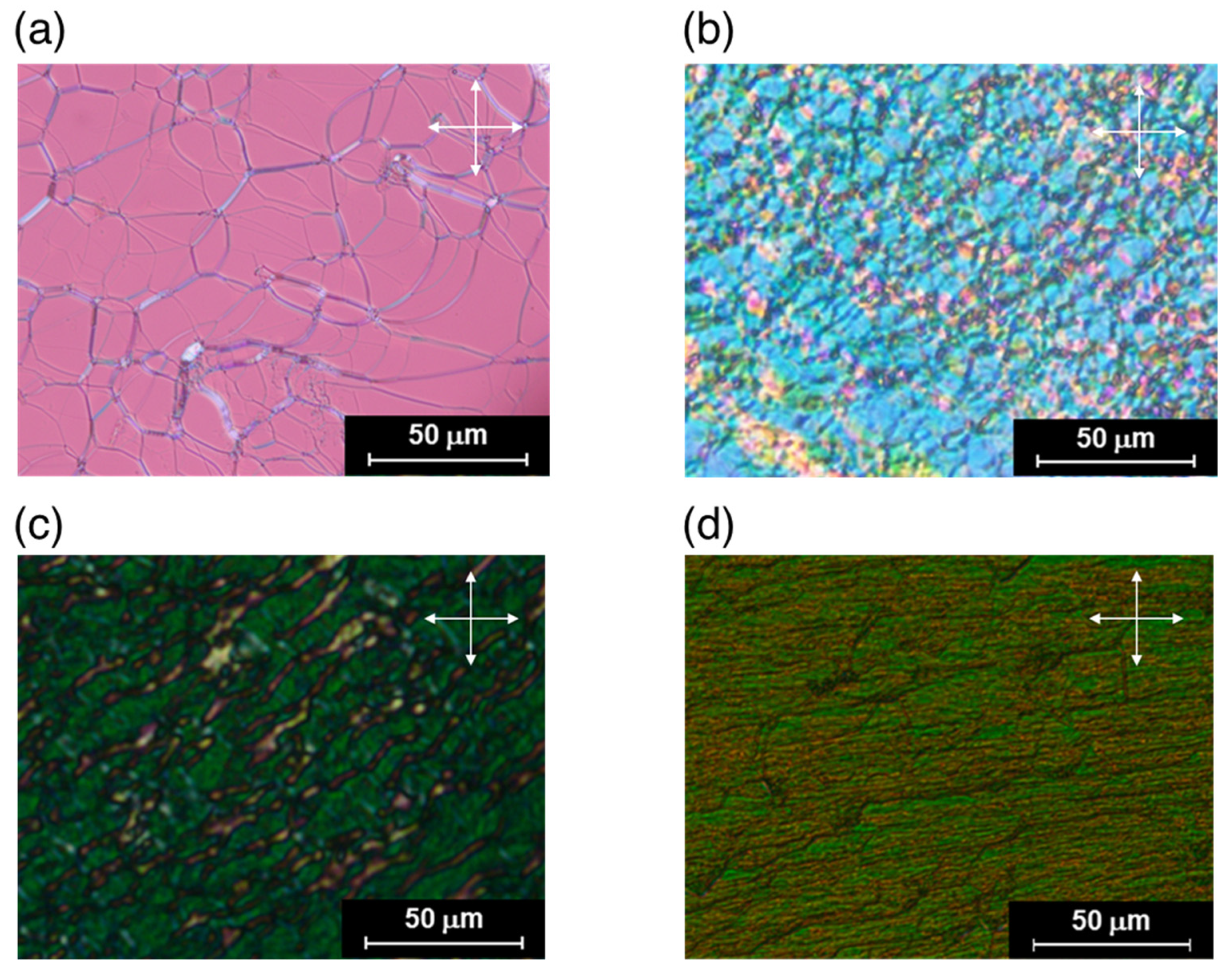

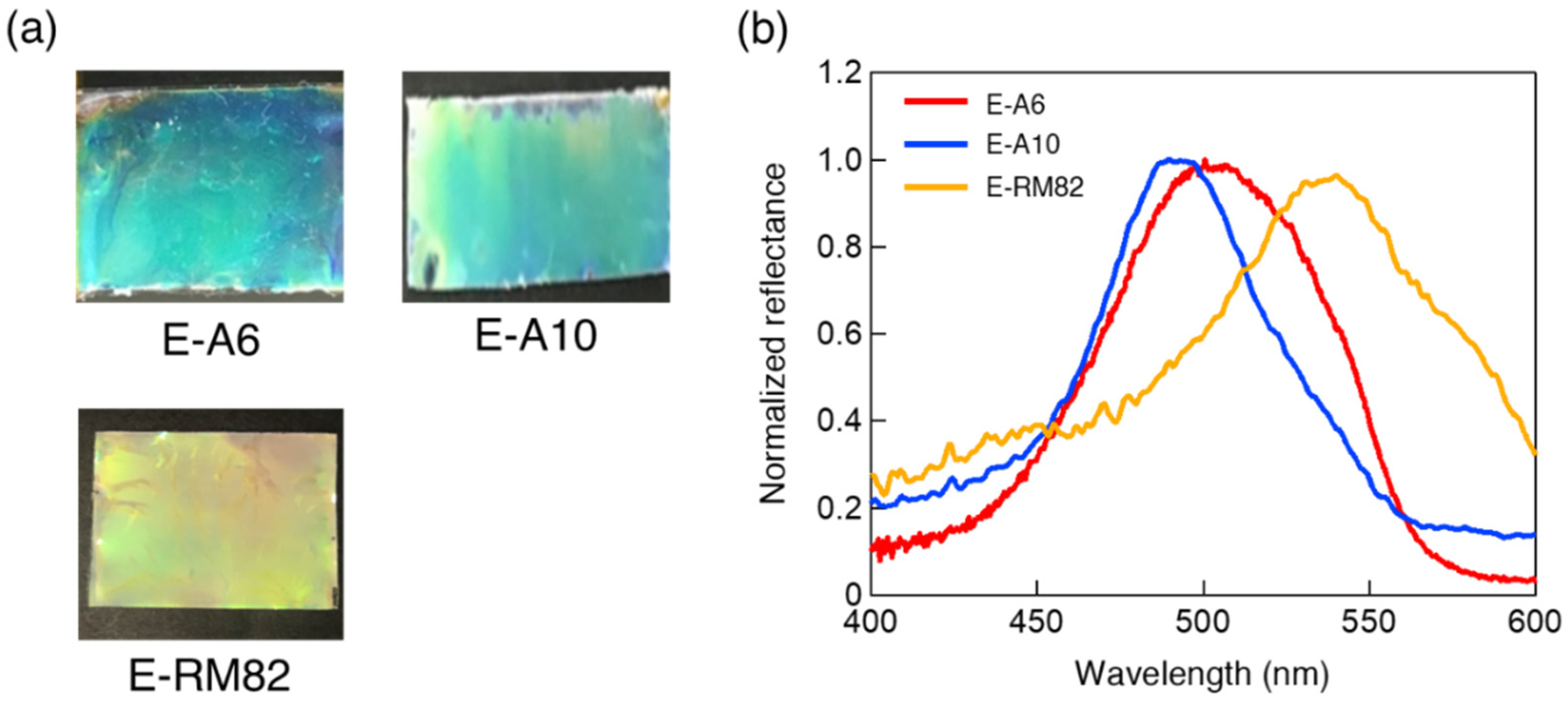
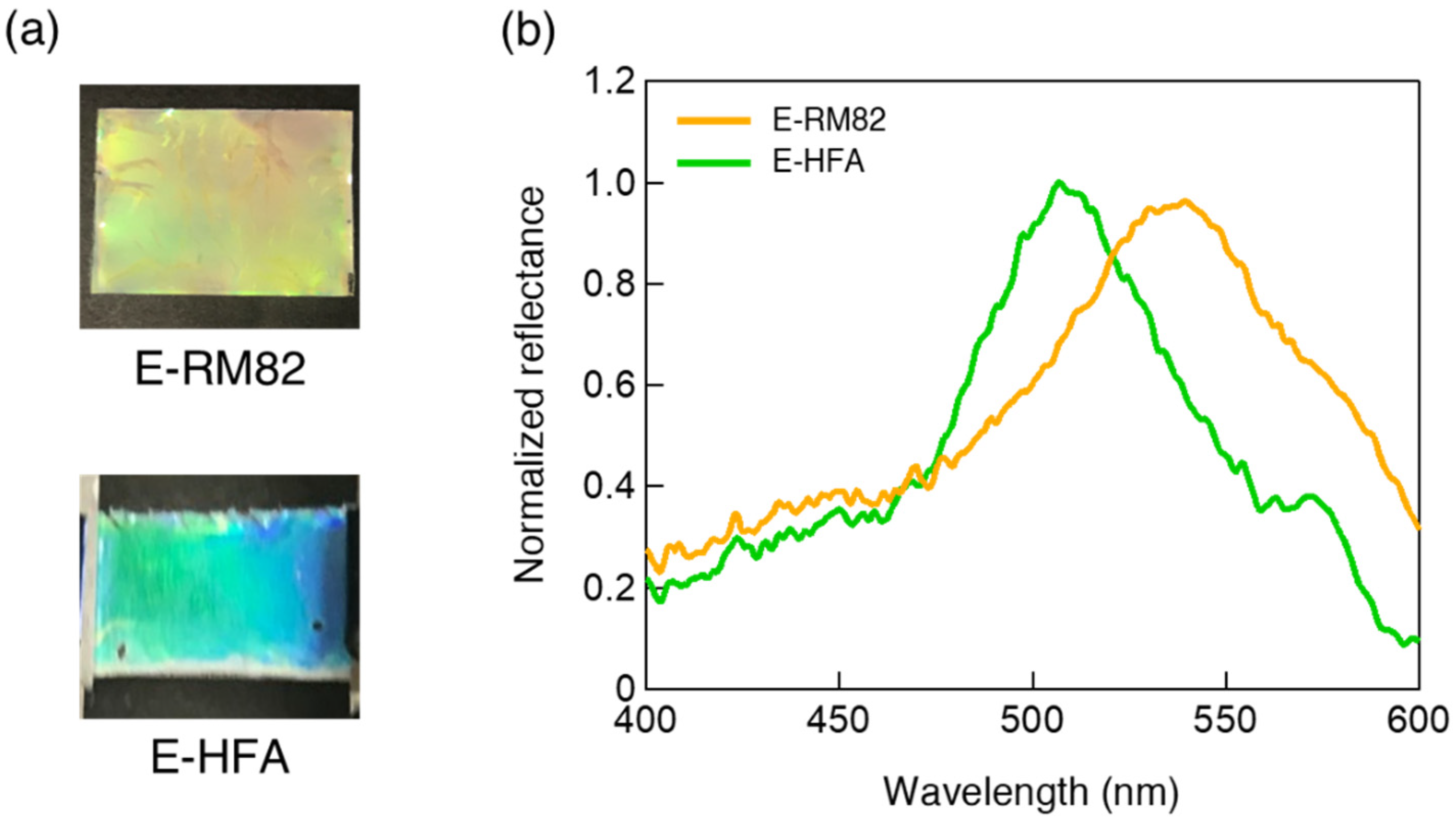
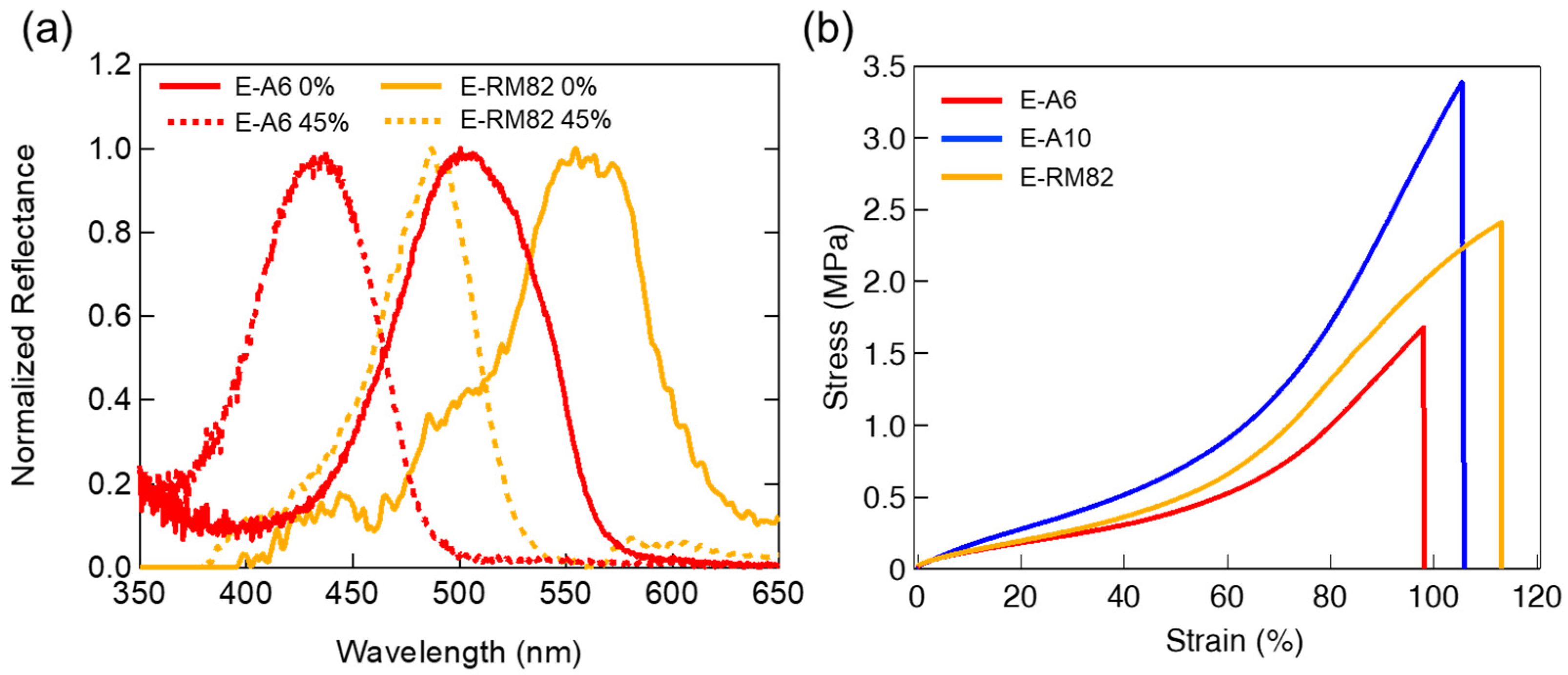

| Crosslinker | Phase Transition Temperature a (°C) | |
|---|---|---|
| Monomer Mixture | N*LCE | |
| A6 | C 22 N* 31 I | G 0 N* 82 I |
| A10 | C 12 N* 26 I | G 2 N* 84 I |
| RM82 | C 22 N* 53 I | G 11 N* 100 I |
| N*LCE | Monomer | Chiral Agent | Plasticizer | Crosslinker | Photoinitiator |
|---|---|---|---|---|---|
| HAB | CHA | 5CB | RM82 | Irgacure651 | |
| E-RM82 | 50 | 30 | 20 | 7.0 | 1.0 |
| E-HFA | 45 | 30 | 18 | 6.4 | 1.0 |
| N*LCE | Monomer | Chiral Agent | Plasticizer | Crosslinker | Photoinitiator | ||
|---|---|---|---|---|---|---|---|
| HAB | CHA | 5CB | A6 | A10 | RM82 | Irgacure 651 | |
| E-A6 | 50 | 30 | 20 | 7.0 | - | - | 1.0 |
| E-A10 | 50 | 30 | 20 | - | 7.0 | - | 1.0 |
| E-RM82 | 50 | 30 | 20 | - | - | 7.0 | 1.0 |
Publisher’s Note: MDPI stays neutral with regard to jurisdictional claims in published maps and institutional affiliations. |
© 2021 by the authors. Licensee MDPI, Basel, Switzerland. This article is an open access article distributed under the terms and conditions of the Creative Commons Attribution (CC BY) license (https://creativecommons.org/licenses/by/4.0/).
Share and Cite
Ku, K.; Hisano, K.; Yuasa, K.; Shigeyama, T.; Akamatsu, N.; Shishido, A.; Tsutsumi, O. Effect of Crosslinkers on Optical and Mechanical Behavior of Chiral Nematic Liquid Crystal Elastomers. Molecules 2021, 26, 6193. https://doi.org/10.3390/molecules26206193
Ku K, Hisano K, Yuasa K, Shigeyama T, Akamatsu N, Shishido A, Tsutsumi O. Effect of Crosslinkers on Optical and Mechanical Behavior of Chiral Nematic Liquid Crystal Elastomers. Molecules. 2021; 26(20):6193. https://doi.org/10.3390/molecules26206193
Chicago/Turabian StyleKu, Kyosun, Kyohei Hisano, Kyoko Yuasa, Tomoki Shigeyama, Norihisa Akamatsu, Atsushi Shishido, and Osamu Tsutsumi. 2021. "Effect of Crosslinkers on Optical and Mechanical Behavior of Chiral Nematic Liquid Crystal Elastomers" Molecules 26, no. 20: 6193. https://doi.org/10.3390/molecules26206193
APA StyleKu, K., Hisano, K., Yuasa, K., Shigeyama, T., Akamatsu, N., Shishido, A., & Tsutsumi, O. (2021). Effect of Crosslinkers on Optical and Mechanical Behavior of Chiral Nematic Liquid Crystal Elastomers. Molecules, 26(20), 6193. https://doi.org/10.3390/molecules26206193







